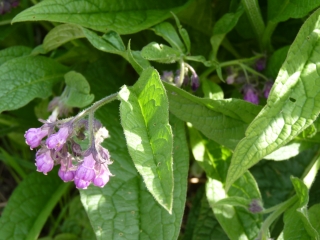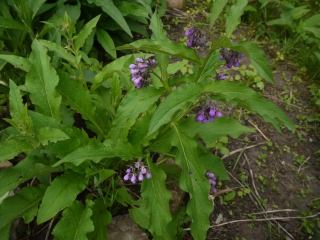home |
avr microcontroller & DIY electronics |
toolbox |
science club |
tuxtalk |
photos |
e-cards |
Online-Shop

no preservatives added blog |
computer and graphics corner |
herbal treasure chest |
splash into math |
stardust |
periodic table
comfrey (symphytum officinale)

how to grow:
Comfrey can be grown from seeds. They are perennials and hardy in US zones 3-8. Comfrey is loved by butterflies and hummingbirds.
medicinal properties:
In folk medicine comfrey was known as the 'knit-together-herb' as it was used to heal the wounds of injured soldiers.
A compress of the freshly meshed roots can be used topically for healing wounds, sprains and even broken bones. For open wounds it is recommended to disinfect the wound first with e.g. propolis tincture or a wash from e.g. thyme and then to apply the compress of comfrey directly to the skin. Comfrey contains allantoin which is the main ingredient responsible for promoting the growth of muscles cells, bone and cartilage. It also helps to stop the bleeding of wounds.
With deep wounds you need to be careful however as the topical wound can close too quickly while the deeper wound hasn't healed yet which can lead to abscesses.
Comfrey can also be used to reduce the swelling of hemorrhoids.

To prepare a compress of comfrey smash the fresh roots in a grinder, then put the mashed comfrey roots directly on the skin and cover it with a clean cloth.
You can also harvest comfrey in spring or fall when the levels of allantoin in the herb are highest and dry them between 40° and 60° C. Now either mash it and mix the powdered comfrey with some vegetable oil or prepare an infusion (1 teaspoon for 1 cup of boiling water, let it steep for 15 minutes and cool down a bit) and then soak it in a clean cloth which you can then put on your skin.
cautions and possible side effects:
- Comfrey should not be taken internally as it contains pyrrolizidine alkaloids which can cause liver and other damage. Russian comfrey is said to contain more pyrrolizidine alkaloids than American comfrey. The root contains higher amounts of it than the leaves and in late summer or fall the amounts are possibly lower than earlier in the year. Only use topically.
further reading:
- A Russian Herbal: Traditional Remedies for Health and Healing by Igor Vilevich Zevin, (Healing Arts Press (1997),ISBN-13: 978-0892815494)
- 20,000 Secrets of Tea: The Most Effective Ways to Benefit from Nature's Healing Herbs by Victoria Zak, (Bantam Doubleday Dell Publishing Group Inc (Dec 1 1999), ISBN-13: 978-0440235293)
- The Herbal Handbook: A User's Guide to Medical Herbalism by David Hoffmann, ( Healing Arts Press; 3rd Edition, Revised Edition of The Herb User's Guide edition (Feb. 1 1998), ISBN-13: 978-0892817825)
- The Way of Herbs by Michael Tierra, ( Gallery Books, 1998, ISBN-13: 978-0671023270);
Copyright © 2004-2025 Katja Socher, tuxgraphics.org



